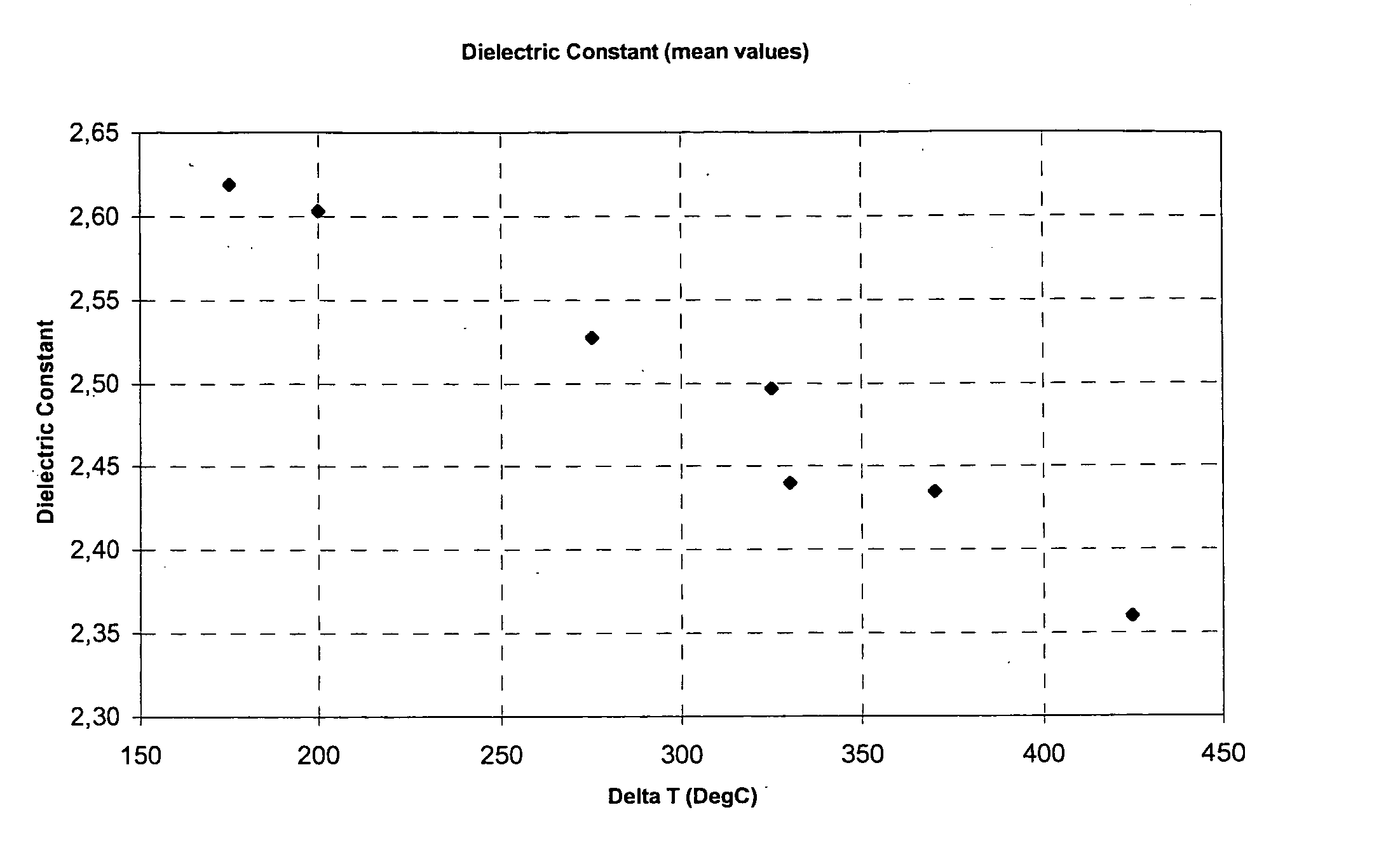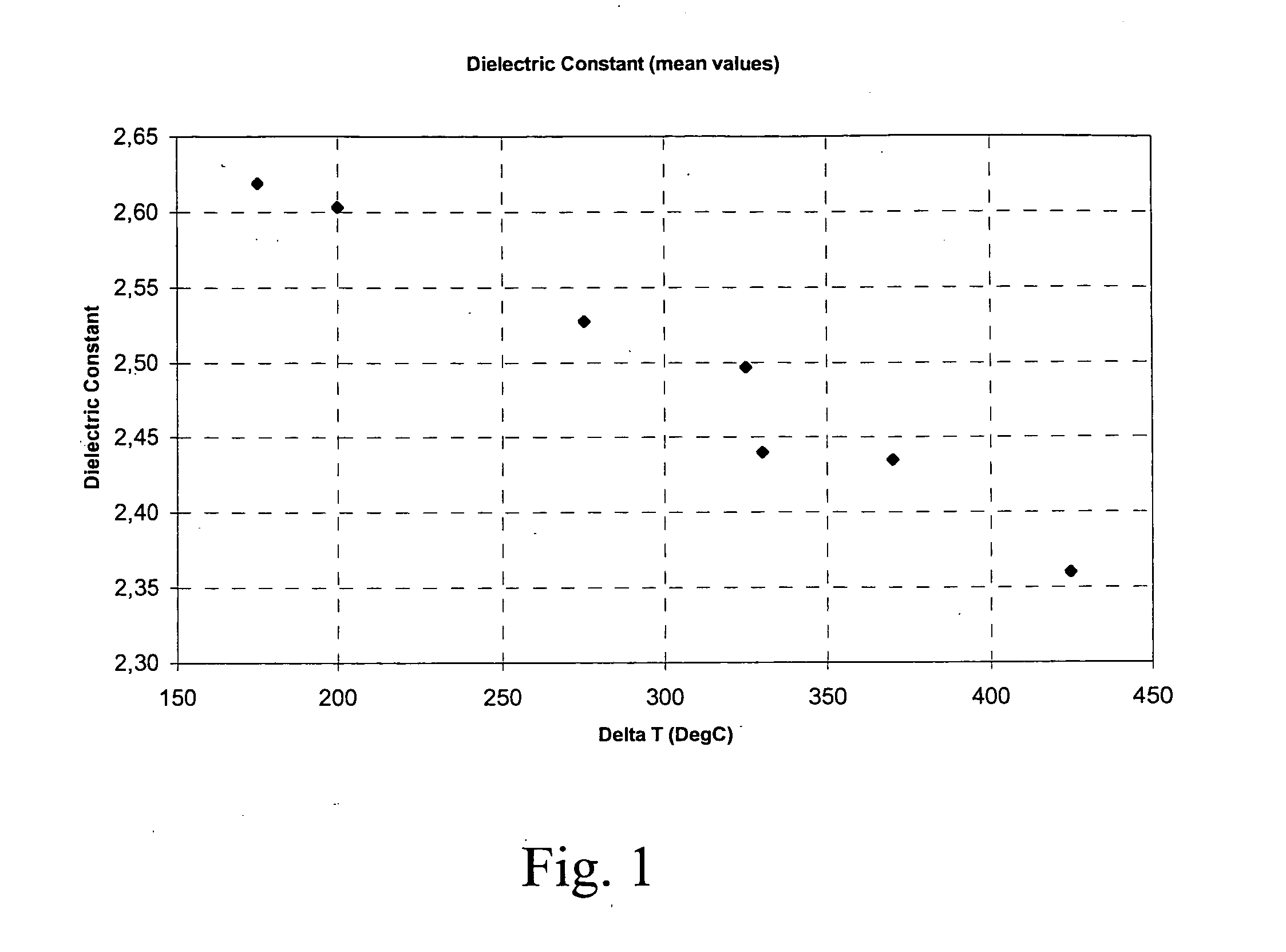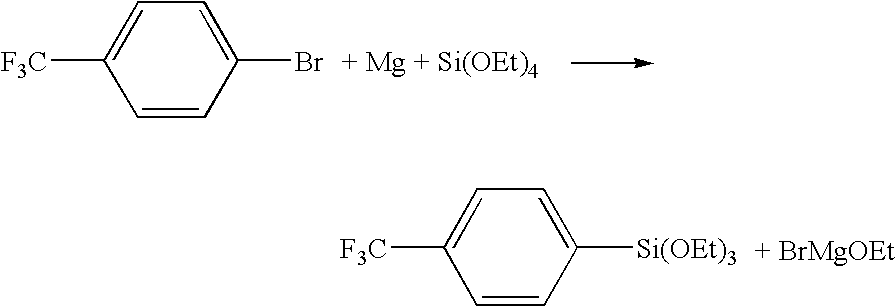Method of forming low-k dielectrics
a dielectric and low-k technology, applied in the field of thin films, can solve the problems of reliability failure, increased softness, brittleness and cracking, and high cost of increased softness, and achieves rapid thermal curing, improved dielectric constant performance, and excellent mechanical and thermal properties
- Summary
- Abstract
- Description
- Claims
- Application Information
AI Technical Summary
Benefits of technology
Problems solved by technology
Method used
Image
Examples
examples
Synthesis of Molecules
(#1) 4-(trifluoromethyl)phenyl trichlorosilane, 4-(F3C)C6H4SiCl3
Preparation:
96.24 g (0.427 mol) 4-(trifluoromethyl)phenyl bromide, 10.38 g (0.427 mol) magnesium, and a small amount of iodine are stirred for half an hour. 356.78 g (382 ml, 1.708 mol) Si(OEt)4 is added to solution. Et2O is added until exothermic reaction occurs (˜200 ml) and the solution is refluxed for over night. Et2O is evaporated off and 250 ml n-heptane is added. Mg-salts are filtered off. n-heptane is evaporated and remaining 4-(F3C)C6H4Si(OEt)3 is purified by distillation. B.p. 68° C. / 1 mbar. Yield 50.22 g (38%).
50.22 g (0.163 mol) 4-(trifluoromethyl)phenyl triethoxysilane, 83 mL (1.140 mol, 135.62 g) thionylchloride and 2.45 g (0.021 mol) pyridinium hydrochloride were refluxed and stirred for 16 h. Excess of SOCl2 was evaporated and residue was fractionally distilled to obtain 37 g (81%) 4-(trifluoromethyl)phenyl trichlorosilane. B.p. 44° C. / 4.0 mbar.
Characterization:
4-(trifl...
example a
Vinyl trichlorosilane (0.05 mol), 4-trifluoromethyl phenyl trichlorosilane (0.45 mol) and methyl trichlorosilane (0.55 mol) are dissolved in dehydrated DCM (800 ml). The solution is added drop-wise into a flask containing excess of water (45 mol) while stirring the solution.
After addition of the water, the solution stirred for 1 hour at the room temperature. The solution is neutralized by water extraction for 12 times and finally volatile components are evaporated with rotary evaporator. After vacuum treatment, dehydrated 400 w-% of mesitylene used as process solvent is added into the material and the material is carefully homogenized. Appropriate initiators are added and dissolved into the mixture. Finally the material is filtered.
example b
Vinyl trichlorosilane (0.05 mol), adamantyltrichlorosilane (0.57 mol) and methyl trichlorosilane (0.38 mol) are dissolved in dehydrated DCM (800 ml). The solution is added drop-wise into a flask containing excess of water (45 mol) while stirring the solution. After addition of the water, the solution stirred for 1 hour at the room temperature. The solution is neutralized by water extraction for 12 times and finally volatile components are evaporated with rotary evaporator. After vacuum treatment, dehydrated 400 w-% of mesitylene used as process solvent is added into the material and the material is carefully homogenized. Appropriate initiators are added and dissolved into the mixture. Finally the material is filtered.
Alternative procedures for each stage:
Instead of DCM (dichloromethane) as a solvent any pure solvent or a mixture of solvents / alternate solvents can be used either by themselves or in combinations. Traditional methods of selecting solvents by using Hansen type para...
PUM
| Property | Measurement | Unit |
|---|---|---|
| temperature | aaaaa | aaaaa |
| temperature | aaaaa | aaaaa |
| temperatures | aaaaa | aaaaa |
Abstract
Description
Claims
Application Information
 Login to View More
Login to View More - R&D
- Intellectual Property
- Life Sciences
- Materials
- Tech Scout
- Unparalleled Data Quality
- Higher Quality Content
- 60% Fewer Hallucinations
Browse by: Latest US Patents, China's latest patents, Technical Efficacy Thesaurus, Application Domain, Technology Topic, Popular Technical Reports.
© 2025 PatSnap. All rights reserved.Legal|Privacy policy|Modern Slavery Act Transparency Statement|Sitemap|About US| Contact US: help@patsnap.com



